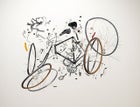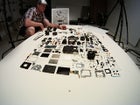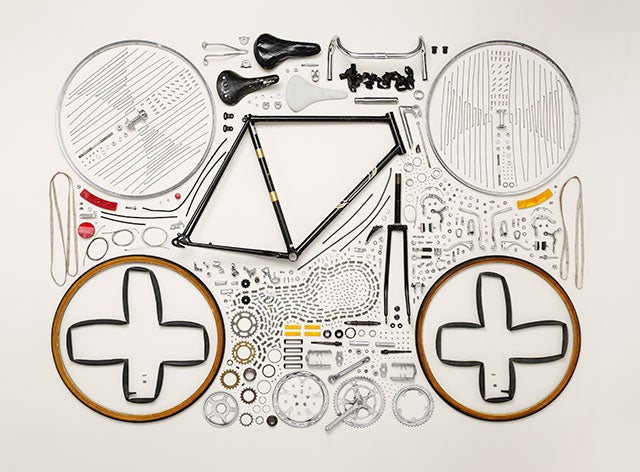Let’s pick apart ’s evolution as a photographer. At age 7 he borrowed his parents’ camera. “I just remember my parents yelling at me for wasting film,” he said. “They ended up giving me a hand-me-down 110.”
Things Come Apart Gallery
View Todd McLellan’s stunning images of gear.Bike falling apart
 Bike falling apart
Bike falling apartTodd McLellan
 McLellan at work
McLellan at workHe took that on some school field trips but never really thought of photography as anything more than pictures you took on trips. After high school, he majored in graphic design at the Alberta College of Art and Design. His mother was an electronics technician. His father was a carpenter. They didn’t quite see the point. “They were like, ‘Well, why wouldn’t you just keep doing what you’re doing?’” said McLellan. “Which was just retail work.”
He signed up for a photography course and was hooked. He graduated, interviewed prominent advertising photographers to learn about the industry, looked for a job, and had two supporters. “Once I graduated, my parents could see the potential,” he said.
He picked up an internship at a large Toronto studio, assisted where and when he could, and concentrated on the technical stuff. Then he hustled until advertisers gave him his own shoots. “I was taking personal photographs, but not a lot that wouldn’t evolve around getting commercial work,” he said.
In any rare off-time, he collected old, interesting objects that other people didn’t want. One of them was a black telephone. In 2009, he thought, “I’ll photograph this, just because it will be cool.” That creative impulse was a departure. “It was one of the first projects where I didn’t do anything in the end for a client,” he said. “I just did what I wanted to do.”
Which is the point at which we ask him to lay out his “Things Come Apart” project for us.
OUTSIDE: How did this project come about?
MCLELLAN: I had a lot of the objects for many years. I wanted to photograph them at some point and just had them sitting around. The phone was the first thing I took apart. I took a picture of it, but it was kind of boring. I’d seen the picture before. I wanted to do something different. I thought, “Gee, it might be cool if you take things apart and lay them out.” I just found out recently that these are called assembly diagrams. Say you’re ordering a part, the diagram shows you what each part is. I wanted to shoot like that. I ended up laying the telephone parts on a glass plate. After I took the picture, I realized that it just required too much follow-up work in Photoshop. I wanted something a little more natural. In commercial work, like in advertising, you have to do a lot of manipulation. I wanted to get a little more grassroots. I wanted to show a product as is, in the best way possible.
So you’ve taken the phone apart and photographed it…
I did the phone on the glass plate and thought it was ridiculous. I thought, I did a simple phone, I’m going to move on to more complex things, like a typewriter. I thought, “Where does it go from here?” I laid out the phone on this white background. I could how this phone came apart and what’s involved in it. I wasn’t creating a pattern. I just wanted the layout to make sense as to how the object was pulled apart.
How did you pick the products?
I collected most everything on street corners or in second-hand shops. I was looking for products people thought they didn’t need anymore. And yes, all the technology was outdated, but it was still very much useful. For example, the typewriter would still type a letter the way it was designed to do so back in the ’60s. I just found it interesting that this stuff had become useless in the way we work.
It worked, but just wasn’t being used?
Yeah, whereas right now, you get a mobile phone and it doesn’t work after two years. I found that, if you did the comparison between phones then and now, it’s kind of shocking.
At what point did you know you had a book?
As I started taking more and more stuff apart. I was doing more and more mechanical things because those are a lot more fun to explore. They’re not being used anymore, and you see people who don’t really care to have them. I was a little reluctant to get into newer technology, but it’s something that I had to explore. I actually was pleasantly surprised at what was involved in them. For mechanical things, you’ll have levers. You press this button to move this thing to move that thing to move that thing. With a mobile phone, you press this button and it sends an electronic signal through who knows where to get to this point here. You can’t really see the mechanics of it, but that’s where the design became very important. It’s pretty amazing how these things are designed to each be contained in one little unit.
So are you taking all of this stuff apart by yourself?
Yes. For me it was a crucial part of the project. The airplane I went to the manufacturer. The good thing about that is airplanes are recycled so you can hardly recognize them. It’s very hard to find a used airplane. They just keep replacing parts, manufacturing new parts, and what not. So that project involved someone out to get the parts of an airplane. I understand now what the parts are. If I wouldn’t have seen someone take it apart, I wouldn’t have understood how to lay it out, which was part of the process. When I’m taking apart a phone or iPad, I know how a part came out of it and I know where I can put it into my layout to make it work.
Describe the process of taking stuff apart and then shooting it. You laid it out neatly, but also captured stuff falling through the air.
For the original seven objects, I created a layout of the all of the pieces. But then I felt like the layout of all of these objects needed a second piece. I just thought, “Screw it, I’m just going to throw these through the air and just use a high speed strobe to capture them flying.” So one portion is somewhat stuffy and the second portion is free flowing.
And why did you want to show both?
Because I think there’s a second part to everything. There’s a nice organized way to doing things and there’s a haphazard way to doing things. I think they work quite well together.
As you’re building up your quiver of products, taking them apart and showing them in two different ways, is there any theme you’re seeing?
No. Overall, it’s just the design of how things are made and how different manufacturers build. For me, it’s just exploring them and seeing how each company does it. I didn’t just pick the high-end companies or the most sought-after objects. I wanted to follow what people are discarding and what’s readily available. When you look at some of the manufacturers on the lower end and some of the manufacturers on the higher end and compare they way they fit things into spaces, it’s interesting. Some polish the insides. Some, when you open they’re products up, you’re like, “Uh.” It just doesn’t look very appealing. But taking apart some of the technologies now, you know that they aren’t meant to be repaired. These things are meant to be replaced.
It seems that a lot of the outdoor gear you photographed hasn’t changed much over time.
No, not at all. I had the Swiss Army knife for over 20 years. It was my own personal knife. After I did it, I thought, OK, I need a new one. And I went and looked, and they look exactly the same as they did 20 years ago. It’s also pretty cool that it lasted that long.
How did you decide to do that knife?
It got really stiff and I had to do a major cleaning. It was a hard decision, but I kind of wanted to see what it looked like. Even as simple as it is, to see how it worked is quite interesting. I thought, OK, I’ll take the hit. I couldn’t put it back together. I ended up not replacing it from the store because I have another one. I don’t plan on taking that one apart. I plan on using that until the end.
Did you see a trend where the older stuff seemed like it would last longer than the newer stuff?
Oh, absolutely. No question. So how can we take a new mobile phone and make it last five or ten years? I mean the shell of it is the shell of it, so if we could change the sock or the internal parts in order to keep down new purchases, in order to keep e-waste as low as possible?
Is taking things apart and putting them back together becoming a lost art?
The TV repair shops are gone now. People doing repairs? It’s hard to find anyone. There’s no reason for it because it’s so expensive. To pay someone to fix your iPhone when you can just buy a new one? If you’re spending $300 to repair your iPhone when you can buy a new one on contract for $150? You’re not going to. The expense is set up for it. And everyone wants new glammy, glitzy things now. And trust me, I’m fighting that all the time. As a photographer, I want the new camera. I try to avoid it. If you have an idea, do whatever you need to do to make that work, but don’t try and live outside of that.
Are there things that you’ve changed in your own life after this project?
Absolutely. I definitely try to make things last as long as I can. Although, a lot of the stuff I took apart, I wouldn’t be able to get back together again. I did take my iPhone completely apart and put it back together, and it works. Although, it’s obsolete now. But I try and do that on a daily basis. If something breaks, how can I fix it myself? Or, What can I do to have someone fix it? I try to not live beyond what I obviously need.
Was there any one product that when you took it apart you were surprised?
The typewriter was interesting. I didn’t realize how many pieces there were in it. I thought it would be a lot simpler. The iPad was quite interesting because a lot of it was held together with tape. In order to fit that much stuff in a really small package, they ended up using a lot of really, really durable tape. Which is kind of interesting. They screwed stuff they needed to and taped the stuff they could get away with, which is functional. And there’s nothing wrong with it. Because it’s such a functional product, you can replace the screen and stuff. In the book it talks about the replacement parts you can get. I think people are becoming interested in that, because as much as you think you don’t know how much stuff works, you can always explore it.
What do you hope that people take away from looking at this book?
It’s just an appreciation of things. Just look at what you have in your hands. A lot of work goes into that. What’s really cool is that you’re seeing a lot of companies that are helping people out in repairing or building some of these things. I think the longer we can make our stuff last, the better. Patagonia, I think it was on your site, they’re doing that “Don’t Buy New.” Just to get that whole process in there is important.
Do you have a favorite shot?
That one changes all of the time. I enjoyed all of the aspects of doing this. The photography, the disassembly, the exploring of the objects… Each one kind of holds its own… It sounds weird to talk about the mechanics of each object like a fond memory, but I kind of enjoyed the jigsaw. It’s not in the book. A reticulating saw, I think most people call it. It was an old mechanical one. I liked seeing how it worked, just the steel and how strong and useful it was. That saw came from a garage sale a few doors down from my house. The lady had a ton of stuff her husband had for years and years and years.
View Todd McLellan’s gallery, Things Come Apart.


